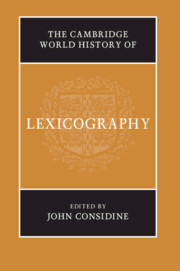Book contents
- The Cambridge World History of Lexicography
- The Cambridge World History of Lexicography
- Copyright page
- Contents
- Contributors
- Editor’s Acknowledgements
- Introduction
- Part I The Ancient World
- Part II The Pre-Modern World
- Part III The Modern World: Continuing Traditions
- 15 China from c. 1700
- 16 Japanese, Korean, and Vietnamese from c. 1800
- 17 Turkish and Persian from c. 1700
- 18 South Asia from c. 1750
- 19 Arabic from c. 1800
- 20 Modern Hebrew
- 21 The Slavic and Baltic Languages
- 22 The Germanic Languages Other than English from c. 1700
- 23 Standard Varieties of English from c. 1700
- 24 Regional Varieties of English
- 25 The Romance Languages from c. 1700
- Part IV The Modern World: Missionary and Subsequent Traditions
- Appendix 1 The Language Varieties
- Appendix 2 The Lexicographers
- Primary Sources
- Secondary Sources
- Index
19 - Arabic from c. 1800
from Part III - The Modern World: Continuing Traditions
Published online by Cambridge University Press: 01 September 2019
- The Cambridge World History of Lexicography
- The Cambridge World History of Lexicography
- Copyright page
- Contents
- Contributors
- Editor’s Acknowledgements
- Introduction
- Part I The Ancient World
- Part II The Pre-Modern World
- Part III The Modern World: Continuing Traditions
- 15 China from c. 1700
- 16 Japanese, Korean, and Vietnamese from c. 1800
- 17 Turkish and Persian from c. 1700
- 18 South Asia from c. 1750
- 19 Arabic from c. 1800
- 20 Modern Hebrew
- 21 The Slavic and Baltic Languages
- 22 The Germanic Languages Other than English from c. 1700
- 23 Standard Varieties of English from c. 1700
- 24 Regional Varieties of English
- 25 The Romance Languages from c. 1700
- Part IV The Modern World: Missionary and Subsequent Traditions
- Appendix 1 The Language Varieties
- Appendix 2 The Lexicographers
- Primary Sources
- Secondary Sources
- Index
Summary
This chapter will cover the lexicography of the Arabic language(s) after 1800. Arabic is spoken by more than 200 million people – and as the (s) after language in the previous sentence indicates, there is not just one Arabic language. Considering Arabic means considering the different variants of the language: the classical language of the Qurʾān, called Classical Arabic; the mostly written (but also spoken) language of the present-day Arab world, called Modern Standard Arabic; and the spoken colloquial languages or dialects of the twenty-two countries where Arabic is the official language, as well as of countries such as Turkey, Iran, Afghanistan, and some areas in sub-Saharan Africa, where we find minority groups who speak varieties of Arabic.
- Type
- Chapter
- Information
- The Cambridge World History of Lexicography , pp. 414 - 430Publisher: Cambridge University PressPrint publication year: 2019

